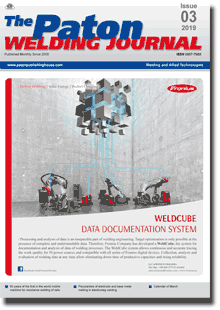| 2019 №03 (08) |
DOI of Article 10.15407/tpwj2019.03.01 |
2019 №03 (02) |

The Paton Welding Journal, 2019, #3, 6-10 pages
Journal The Paton Welding Journal
Publisher International Association «Welding»
ISSN 0957-798X (print)
Issue #3, 2019 (March)
Pages 6-10
Peculiarities of electrode and base metal melting in electroslag welding
I.I. Lychko, K.A. Yushchenko, S.A. Suprun and S.M. Kozulin
E.O. Paton Electric Welding Institute of the NAS of Ukraine 11 Kazimir Malevich Str., 03150, Kyiv, Ukraine. E-mail: office@paton.kiev.ua
Results of experimental studies of the connection between the processes proceeding in the electrode wire melting zone and electric parameters of the electroslag welding mode are described. The experimental procedure envisaged electroslag welding of specimens from 60 mm thick steel 09G2S the in modes identical to those, used earlier for photographing and filming the welding zone through an optically transparent medium. Hall sensor, ADC module E-140 and «Power Graph» software were applied for high-speed recording of electric parameters of mode (10 thou records per second). Measurements of slag pool temperature near the electrode wire melting zone were taken simultaneously. Analysis and comparison of visual observations of the welding zone through an optically transparent medium with the characteristics of electroslag welding mode (Uw, Iw, Vw.f) were performed, confirming the cyclic existence of some nucleus in the molten slag between the electrode wire and liquid metal, formed under the effect of electric potential between the base and electrode metal. 9 Ref., 4 Figures.
Keywords: electroslag welding, slag pool, interelectrode gap, high-speed recoding of electric parameters of mode, active zone, energetic nucleus, «discharge», melting and transfer of liquid metal, high-speed photographing and filming
Received: 15.11.18
Published: 11.04.19
References
1. Voloshkevich, G.Z. (1955) X-ray investigation of electrode melting and metal transfer. In: Problems of electric arc and resistance welding. Moscow, Mashgiz, 292-300 [in Russian].2. Voloshkevich, G.Z. (1958) Electrode melting and metal transfer in electroslag welding. Avtomatich. Svarka, 10, 14-21 [in (1980) Electroslag welding and surfacing. Ed. by B.E. Paton. Moscow, Mashinostroenie [in Russian].
3. Ando, A., Nakata, S., Wada, H. (1970) Studies on the electroslag welding (Report 111). J. Jap. Weld. Soc., 40(11), 1104-1110. https://doi.org/10.2207/qjjws1943.40.1104
4. Kaluc, E., Taban, E., Dhooge, A. (2006) Electroslag welding process and industrial applications. Metal Dunyasi, Ocak 2006 Sayi: 152, Yil: 13, Sayfa, 100-104 [in Turkish].
5. Brandi, S.D., Liu, S., Thomas, R.D. (2012) Electroslag and electrogas welding. AWS Welding Handbook, 6A, 365-379. https://doi.org/10.31399/asm.hb.v06a.a0005591
6. Konigsmark, J. (1970) Direct observation of electroslag process at welding with wire electrode with diameter of 3.15 mm. Zvaranie, 19(9-10), 265-269 [in Slovak].
7. Dudko, D.A., Voloshkevich, G.Z., Sushchuk-Slyusarenko, I.I., Lychko, I.I. (1971) Study of electroslag process using filming and photography through transparent medium. Avtomatich. Svarka, 2, 15-17 [in Russian].
8. Paton, B.E., Lychko, I.I., Yushchenko, K.A. et al. (2013) Melting of electrode and base metal in electroslag welding. The Paton Welding J., 7, 31-38.
